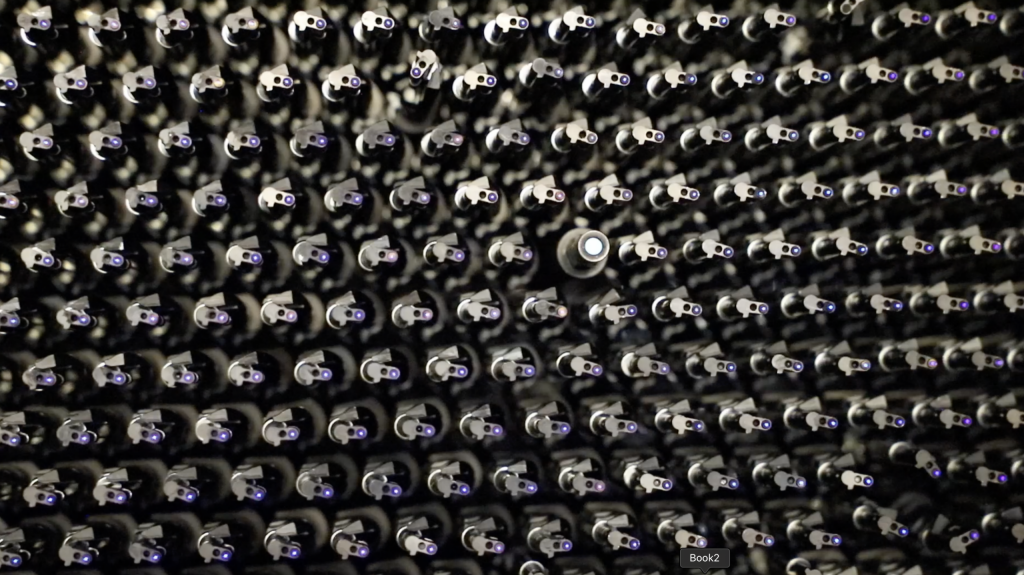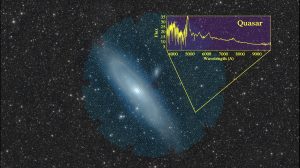Editor’s note: The Dark Energy Spectroscopic Instrument seeks to further our cosmic understanding by creating the largest 3D map of galaxies to date. Below is a press release issued by the Department of Energy’s Lawrence Berkeley National Laboratory announcing the official start of DESI’s five-year survey. DOE’s Fermi National Accelerator Laboratory is a key player in the construction of this instrument, drawing on more than 25 years of experience with the Sloan Digital Sky Survey and the Dark Energy Survey.
Fermilab contributed key elements to DESI, including the online databases used for data acquisition and the software that will ensure that each of the 5,000 robotic positioners are precisely pointing to their celestial targets to within a tenth of the width of a human hair. Fermilab also contributed the corrector barrel, hexapod and cage. The corrector barrel holds DESI’s six large lenses in precise alignment. The hexapod, designed and built with partners in Italy, focuses the DESI images by moving the barrel-lens system. Both the barrel and hexapod are housed in the cage, which provides the attachment to the telescope structure. In addition, Fermilab carried out the testing and packaging of DESI’s charge-coupled devices, or CCDs. The CCDs convert the light passing through the lenses from distant galaxies into digital information that can then be analyzed by the collaboration.
“It is very exciting to have reached this point in the project,” said Liz Buckley-Geer, Fermilab scientist and one of the DESI lead observers. “I am looking forward to participating in the exciting science results that will be produced in the coming years.”
A five-year quest to map the universe and unravel the mysteries of “dark energy” is beginning officially today, May 17, at Kitt Peak National Observatory near Tucson, Arizona. To complete its quest, the Dark Energy Spectroscopic Instrument (DESI) will capture and study the light from tens of millions of galaxies and other distant objects in the universe.
DESI is an international science collaboration managed by the Department of Energy’s Lawrence Berkeley National Laboratory, or Berkeley Lab, with primary funding from DOE’s Office of Science.
By gathering light from some 30-million galaxies, project scientists say DESI will help them construct a 3D map of the universe with unprecedented detail. The data will help them better understand the repulsive force associated with “dark energy” that drives the acceleration of the expansion of the universe across vast cosmic distances.
Jim Siegrist, associate director for High Energy Physics at DOE, says “We are excited to see the start of DESI, the first next-generation dark energy project to begin its science survey. Along with its primary mission of dark energy studies, the data set will be of use by the wider scientific community for a multitude of astrophysics studies.”

A small section of the DESI focal plane, showing the one-of-a-kind robotic positioners. The optical fibers, which are installed in the robotic positioners, are backlit with blue light in this image. Photo: DESI collaboration
What sets DESI apart from previous sky surveys? The project director, Berkeley Lab’s Michael Levi, said, “We will measure 10 times more galaxy spectra than ever obtained. These spectra get us a third dimension.” Instead of two-dimensional images of galaxies, quasars and other distant objects, he explained, the instrument collects light, or spectra, from the cosmos such that it “becomes a time machine where we place those objects on a timeline that reaches as far back as 11-billion years ago.”
“DESI is the most ambitious of a new generation of instruments aimed at better understanding the cosmos — in particular, its dark energy component,” said project co-spokesperson Nathalie Palanque-Delabrouille, a cosmologist at France’s Alternative Energies and Atomic Energy Commission, or CEA. She said the scientific program — including her own interest in quasars — will allow researchers to address with precision two primary questions: what is dark energy; and the degree to which gravity follows the laws of general relativity, which form the basis of our understanding of the cosmos.

The disk of the Andromeda Galaxy, M31, which spans more than 3 degrees, is targeted by a single DESI pointing, represented by the large, pale green, circular overlay. The smaller circles within this overlay represent the regions accessible to each of the 5,000 DESI robotic fiber positioners. In this sample, the 5,000 spectra that were simultaneously collected by DESI include not only stars within the Andromeda Galaxy, but also distant galaxies and quasars. The example DESI spectrum that overlays this image is of a distant quasar, QSO, 11-billion years old. Image: DESI collaboration and DESI Legacy Imaging Surveys
“It’s been a long journey from the first steps that we took almost a decade ago to design the survey, then to decide which targets to observe, and now to have the instruments so that we can achieve those science goals,” Palanque-Delabrouille, said. “It’s very exciting to see where we stand today.”
The formal start of DESI’s five-year survey follows a four-month trial run of its custom instrumentation that captured 4-million spectra of galaxies — more than the combined output of all previous spectroscopic surveys.
The DESI instrument resides at the retrofitted Nicholas U. Mayall 4-meter Telescope at Kitt Peak National Observatory, a program of the National Science Foundation’s NOIRLab. The instrument includes new optics that increase the field of view of the telescope and includes 5,000 robotically controlled optical fibers to gather spectroscopic data from an equal number of objects in the telescope’s field of view.
“We’re not using the biggest telescopes,” said Berkeley Lab’s David Schlegel, who is DESI project scientist. “It’s that the instruments are better and very highly multiplexed, meaning that we can capture the light from many different objects at once.”
In fact, the telescope “is literally pointing at 5,000 different galaxies simultaneously,” Schlegel said. On any given night, he explains, as the telescope is moved into a target position, the optical fibers align to collect light from galaxies as it is reflected off the telescope mirror. From there, the light is fed into a bank of spectrographs and CCD cameras for further processing and study.
“It’s really a factory that we have — a spectra factory,” said survey validation lead, Christophe Yeche, also a cosmologist at CEA. “We can collect 5,000 spectra every 20 minutes. In a good night, we collect spectra from some 150,000 objects.”
“But it’s not just the instrument hardware that got us to this point — it’s also the instrument software, DESI’s central nervous system,” said Klaus Honscheid, a professor of physics at Ohio State University who directed the design of the DESI instrument control and monitoring systems. He credits scores of people in his group and around the world who have built and tested thousands of DESI’s component parts, most of which are unique to the instrument.
Spectra collected by DESI are the components of light corresponding to the colors of the rainbow. Their characteristics, including wavelength, reveal information such as the chemical composition of objects being observed as well as information about their relative distance and velocity.
As the universe expands, galaxies move away from each other, and their light is shifted to longer, redder wavelengths. The more distant the galaxy, the greater its “redshift.” By measuring galaxy redshifts, DESI researchers will create a 3D map of the universe. The detailed distribution of galaxies in the map is expected to yield new insights on the influence and nature of dark energy.
“Dark energy is one of the key science drivers for DESI,” said project co-spokesperson Kyle Dawson, a professor of physics and astronomy at University of Utah. “The goal is not so much to find out how much there is – we know that about 70% of the energy in the universe today is dark energy — but to study its properties.”
The universe is expanding at a rate determined by its total energy contents, Dawson explains. As the DESI instrument looks out in space and time, he says, “we can literally take snapshots today, yesterday, 1-billion years ago, 2-billion years ago — as far back in time as possible. We can then figure out the energy content in these snapshots and see how it is evolving.”
DESI is supported by the DOE Office of Science and by the National Energy Research Scientific Computing Center, a DOE Office of Science user facility. Additional support for DESI is provided by the U.S. National Science Foundation; the Science and Technologies Facilities Council of the United Kingdom; the Gordon and Betty Moore Foundation; the Heising-Simons Foundation; the French Alternative Energies and Atomic Energy Commission, or the CEA; the National Council of Science and Technology of Mexico; the Ministry of Economy of Spain; and by the DESI member institutions.
The DESI collaboration is honored to be permitted to conduct astronomical research on Iolkam Du’ag (Kitt Peak), a mountain with particular significance to the Tohono O’odham Nation.
DESI is supported by the DOE Office of Science.
Fermilab is supported by the Office of Science of the U.S. Department of Energy. The Office of Science is the single largest supporter of basic research in the physical sciences in the United States and is working to address some of the most pressing challenges of our time. For more information, visit science.energy.gov.
DOE’s Office of Science is the single largest supporter of basic research in the physical sciences in the United States and is working to address some of the most pressing challenges of our time. For more information, please visit science.energy.gov.
The Science and Technology Facilities Council, or STFC, has signed an agreement with Fermi National Accelerator Laboratory, in the United States, designating how the two organizations will collaborate to build one of the world’s most powerful linear accelerators.
Based at the U.S. Department of Energy’s Fermilab, the PIP-II accelerator, currently under construction, is an essential upgrade to the accelerator complex — and once complete, will enable the world’s most powerful high-energy neutrino beams.
This will allow physicists to study the elusive neutrino particle — known for having very little mass, traveling at nearly the speed of light and possibly holding the secrets to some of the biggest unanswered questions in physics.

STFC Executive Chair Mark Thomson and Fermilab Director Nigel Lockyer sign the agreement detailing how the organizations will collaborate to build one of the world’s most powerful linear accelerators. Photo: STFC
The U.K. and the PIP-II accelerator
Today’s agreement sets out how the U.K. will contribute to the PIP-II accelerator project, which provides the engine for the highly-anticipated global science experiment, the Deep Underground Neutrino Experiment, or DUNE, hosted by Fermilab.
DUNE is an international flagship science experiment designed to study neutrinos. Results from studies looking at the neutrino particle could potentially revolutionize our understanding of the universe.
The PIP-II accelerator will also power a suite of other experiments at Fermilab. Its high-power beams can be delivered to multiple experiments at once.
The agreement was signed by STFC’s Executive Chair Mark Thomson and Fermilab Director Nigel Lockyer.
Thomson said:
“Today’s agreement further strengthens the U.K.’s collaboration with our U.S. partners in this crucial project, which sits at the heart of a new globally significant facility at Fermilab.
“STFC’s continued commitment to the Fermilab neutrino program will pave the way for fundamental discoveries into the nature of these most elusive particles, and will provide key insights into the origins and evolution of the universe.”
The U.K.’s involvement in the upgrade has been made possible through the U.K. Government’s £79-million investment in the DUNE experiment, Long-Baseline Neutrino Facility, also known as LBNF, and the new PIP-II accelerator.
This investment, delivered by STFC, has given U.K. scientists and engineers the chance to take leading roles in the management and development of the DUNE far detector, the LBNF neutrino beam targetry and the PIP-II accelerator.
International collaboration
Five nations are collaborating together with the United States to build the powerful PIP-II accelerator: France, India, Italy, Poland and the U.K.
“We are grateful for the world-class expertise and contributions of our international collaborators in building a state-of-the-art particle accelerator powering the world’s most intense neutrino beam. This upgraded technology will drive the next 50 years of global neutrino research in particle physics and the Science and Technology Facilities Council’s contributions will help make this possible,” said Nigel Lockyer, Fermilab director.
In the U.K., STFC will design, build and qualify vital elements of the 215-meter-long particle accelerator, which will accelerate the proton beam to its highest energy.
The main elements currently being developed at STFC’s Daresbury Laboratory are the superconducting cryomodules.
Cryomodules act like a large cooler, working at minus-271 degrees Celsius, to keep the instruments inside, known as radio-frequency cavities, or RF cavities, cryogenically cooled.
RF cavities store the energy needed to accelerate the proton beam, which, when fired into a carbon or beryllium target, will produce a high intensity beam of neutrinos.
By making the RF cavities from a material called niobium — which is both malleable and is superconducting at low temperatures, they become extremely efficient and need very little electrical power to achieve the powerful beam acceleration.
A powerful proton beam striking a target is critical for the study of neutrinos because neutrinos do not interact with other particles very often, which makes them hard to spot, so scientists need to produce lots of neutrinos to detect even one in the massive detectors.
Niobium is a rare metal with only a few sources and suppliers around the world. It is also not an easy material to work with, as it reacts with oxygen in the air at high temperatures — such as the high temperatures found in the welding process.
STFC has been working closely with industry partner The Welding Institute, or TWI, in Cambridge, U.K., which has commissioned the U.K.’s first electron beam welder able to weld in vacuum the high-purity niobium cavities.
Delivering world-class science at Daresbury
Teams of scientists, engineers and technicians at STFC’s Daresbury Laboratory, working with TWI, will construct three cryomodules, each housing six superconducting RF cavities, or SRF cavities. Before installing into the cryomodules, each cavity will be thoroughly tested using STFC’s Daresbury Laboratory SRF Lab, also known as SuRFLab, facility.
Now 18 months into the project, the STFC Daresbury Laboratory team is making its way through major milestones, including the completion of the cryomodule transport system design.
Once the cryomodules are built, each of them will need to be safely transported to Fermilab in the United States. The transport frame has to protect the cryomodule and all its high-tech components during transportation.
Peter McIntosh, PIP-II principal investigator and deputy director, ASTeC at STFC’s Daresbury Laboratory, said:
“The UK, STFC and Daresbury Laboratory in particular have a fantastic opportunity to provide cutting-edge accelerator technologies for ‘powering the heart’ of the international flagship project LBNF/DUNE in the United States.
“I am immensely proud of how the delivery team at Daresbury, along with our industry partners, have adapted to the challenges faced in developing our leading provision of superconducting cryomodules for PIP-II.”
Editor’s Notes
How does PIP-II work?
The PIP-II linear accelerator works by applying an alternating electromagnetic field to a beam of protons.
By attracting the moving particles at just the right time, it causes them to gain speed.
Particles are accelerated under high vacuum in special structures called cavities. Due to the significant amount of power required to accelerate the beam to high energies, even good electrical conductors like copper are unsuitable for use as cavities in this type of machine as they would convert too much power to heat.
Making cavities from superconducting materials such as niobium, significantly increases the machine’s efficiency as superconductors offer virtually zero electrical resistance to the power source. These materials only become superconducting at very low temperatures and must therefore be cryogenically cooled.
The cavities are housed in protective vessels called cryomodules. These insulating devices provide a sealed envelope for the SRF cavities, allowing them to be cooled down to 2 Kelvin or minus-271 degrees Celsius.
Imagery with captions and credits: https://ukri.box.com/s/tooux3op677em2x69a4ndzuiyl344cxp
About the Science and Technology Facilities Council
The Science and Technology Facilities Council, or STFC, is part of UK Research and Innovation — the U.K. body that works in partnership with universities, research organizations, businesses, charities and government to create the best possible environment for research and innovation to flourish. For more information visit U.K. Research and Innovation.
STFC funds and supports research in particle and nuclear physics, astronomy, gravitational research and astrophysics, and space science and also operates a network of five national laboratories, including the Rutherford Appleton Laboratory and the Daresbury Laboratory, as well as supporting U.K. research at a number of international research facilities including CERN, Fermilab, the ESO telescopes in Chile and many more. Visit https://stfc.ukri.org/ and follow @STFC_Matters for more information.
About Fermilab
Fermilab is America’s premier national laboratory for particle physics research. A U.S. Department of Energy Office of Science laboratory, Fermilab is located near Chicago, Illinois, and operated under contract by the Fermi Research Alliance LLC. Visit Fermilab’s website at https://www.fnal.gov and follow us on Twitter @Fermilab.
The DOE Office of Science is the single largest supporter of basic research in the physical sciences in the United States and is working to address some of the most pressing challenges of our time. For more information, visit https://science.energy.gov.
